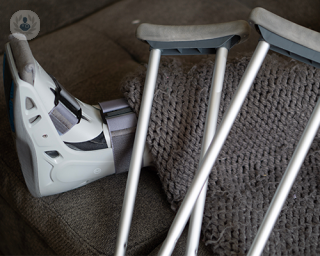What is an ankle arthroscopy?
An ankle arthroscopy is a type of minimally invasive surgery that enables the surgeon to view and operate on the joint without having to make a big incision. Small incisions, roughly about one centimetre big, are made.
An ankle arthroscopy is often done to clean the joint and remove any unwanted tissue, or it can be used for treating osteochondritis for example. It is normally done under general anaesthetic.
Why would you do it?
An ankle arthroscopy may be carried out due to one of the following problems:
- ankle pain
- ligament tears
- ankle impingement
- scar tissue
- arthritis
- cartilage injuries
- loose fragments
What does it involve?
During the procedure, the surgeon inserts an arthroscope into the ankle through a small cut. The arthroscope is connected to the monitor which allows the surgeon to see inside the ankle and see what tissues may be damaged (cartilage, bones, or tendons), and operate on them. This is done through several small cuts through which the arthroscope and surgical instruments are inserted.
If the condition is very serious, open surgery will be considered. This type of surgery involves making a large incision to be able to see and access the damaged bones and tissues.
How to prepare for it
The specialist will study the patient’s history and, for two weeks before the surgery, may request the patient to:
- Not take anticoagulants
- Take prescribed medication the day of the surgery
On the day of the surgery, the patient should:
- Not eat or drink before the procedure
- Take any medication needed with a small sip of water
Post-operative care
After the procedure, a week’s rest is recommended. Other recommendations include applying ice to prevent swelling. The patient may be given some physiotherapy exercises to follow or be recommended lymphatic drainage, among other techniques, to increase ankle movement.
Alternative treatments
An ankle arthroscopy is a relatively new treatment within the branch of ankle surgeries.
There are other kinds of treatment available, such as open ankle surgery which is used to alleviate pain in the area. This technique is generally used if minimally invasive surgery cannot be performed.
There is another technique known as percutaneous foot surgery, which is used for other foot conditions such as bone or soft tissue alterations.
11-13-2012 11-10-2023Ankle arthroscopy
Mr Hisham Shalaby - Orthopaedic surgery
Created on: 11-13-2012
Updated on: 11-10-2023
Edited by: Carlota Pano
What is an ankle arthroscopy?
An ankle arthroscopy is a type of minimally invasive surgery that enables the surgeon to view and operate on the joint without having to make a big incision. Small incisions, roughly about one centimetre big, are made.
An ankle arthroscopy is often done to clean the joint and remove any unwanted tissue, or it can be used for treating osteochondritis for example. It is normally done under general anaesthetic.
Why would you do it?
An ankle arthroscopy may be carried out due to one of the following problems:
- ankle pain
- ligament tears
- ankle impingement
- scar tissue
- arthritis
- cartilage injuries
- loose fragments
What does it involve?
During the procedure, the surgeon inserts an arthroscope into the ankle through a small cut. The arthroscope is connected to the monitor which allows the surgeon to see inside the ankle and see what tissues may be damaged (cartilage, bones, or tendons), and operate on them. This is done through several small cuts through which the arthroscope and surgical instruments are inserted.
If the condition is very serious, open surgery will be considered. This type of surgery involves making a large incision to be able to see and access the damaged bones and tissues.
How to prepare for it
The specialist will study the patient’s history and, for two weeks before the surgery, may request the patient to:
- Not take anticoagulants
- Take prescribed medication the day of the surgery
On the day of the surgery, the patient should:
- Not eat or drink before the procedure
- Take any medication needed with a small sip of water
Post-operative care
After the procedure, a week’s rest is recommended. Other recommendations include applying ice to prevent swelling. The patient may be given some physiotherapy exercises to follow or be recommended lymphatic drainage, among other techniques, to increase ankle movement.
Alternative treatments
An ankle arthroscopy is a relatively new treatment within the branch of ankle surgeries.
There are other kinds of treatment available, such as open ankle surgery which is used to alleviate pain in the area. This technique is generally used if minimally invasive surgery cannot be performed.
There is another technique known as percutaneous foot surgery, which is used for other foot conditions such as bone or soft tissue alterations.


Post-op instructions: when can I walk after ankle arthroscopy?
By Mr Tarek El Gamal
2024-11-21
Learn from Mr Tarek El Gamal, an expert in ankle arthroscopy, about what to expect post-op, including when you can walk, get back to work and return to sports. See more


An expert on ankle arthroscopy
By Mr Simon Moyes
2024-11-20
In our latest article, renowned London-based orthopaedic surgeon Mr Simon Moyes explains exactly what ankle arthoscopy is and how it is performed. He outlines the risk and side effects, as well as highlighing the effectiveness of the treatment and it's overwhelmingly positive success rate. See more


Ankle arthroscopy: A quick guide
By Mr Raheel Shariff
2024-11-19
In his latest online article, renowned consultant orthopaedic surgeon Mr Raheel Shariff explains what an ankle arthroscopy is, when it is recommended and what the benefits are. See more


An in-depth guide to ankle arthroscopy: Understanding treatment, recommendations, and recovery
By Mr Efstathios Drampalos
2024-11-19
Ankle arthroscopy is a minimally invasive surgical procedure that has become increasingly popular for treating a range of ankle-related issues. In this comprehensive guide, renowned consultant orthopaedic foot and ankle surgeon Mr Efstathios Drampalos explores the purpose of ankle arthroscopy, when it is recommended, and what patients can expect during the recovery period. See more
Experts in Ankle arthroscopy
-
Mr Rohit Madhav
Orthopaedic surgeryExpert in:
- Sports traumatology
- Minimally invasive bunion surgery
- Ankle arthroscopy
- Tendon injuries
- Foot fracture
- Bunion (hallux valgus)
-
Mr David Redfern
Orthopaedic surgeryExpert in:
- Bunion (hallux valgus)
- Sports injuries
- Minimally invasive bunion surgery
- Ankle replacement surgery
- Ankle arthroscopy
- Arthritis
-
Mr Stephen Bendall
Orthopaedic surgeryExpert in:
- Foot and ankle
- Ankle arthroscopy
- Arthritis
- Minimally invasive bunion surgery
- Sports injuries
- Flat feet
-
Mr Samer Morgan
Orthopaedic surgeryExpert in:
- Ankle replacement surgery
- Foot and ankle
- Achilles tendon
- Minimally invasive bunion surgery
- Joint injections
- Sports injuries
-
Mr Billy Jowett
Orthopaedic surgeryExpert in:
- Bunion (hallux valgus)
- Arthritis
- Ankle
- Flat feet
- Achilles tendon
- Ankle arthroscopy
- See all

LycaHealth Canary Wharf
LycaHealth Canary Wharf
1 Westferry Circus, Canary Wharf. E14 4HD
No existe teléfono en el centro.
By using the telephone number provided by TOP DOCTORS, you automatically agree to let us use your phone number for statistical and commercial purposes. For further information, read our Privacy Policy
Top Doctors

Kings Park Hospital - part of Circle Health Group
Kings Park Hospital - part of Circle Health Group
Polmaise Road Stirling FK7 9JH
No existe teléfono en el centro.
By using the telephone number provided by TOP DOCTORS, you automatically agree to let us use your phone number for statistical and commercial purposes. For further information, read our Privacy Policy
Top Doctors

Sheffield Orthopaedics Ltd
Sheffield Orthopaedics Ltd
Claremont Hospital, 401 Sandygate Rd, Sheffield
No existe teléfono en el centro.
By using the telephone number provided by TOP DOCTORS, you automatically agree to let us use your phone number for statistical and commercial purposes. For further information, read our Privacy Policy
Top Doctors
-
LycaHealth Canary Wharf
1 Westferry Circus, Canary Wharf. E14 4HD, Central LondonExpert in:
- Cardiology
- Dermatology
- Diagnostic Imaging
- Women’s health
-
Kings Park Hospital - part of Circle Health Group
Polmaise Road Stirling FK7 9JH, StirlingExpert in:
- Vascular Surgery
- Cardiology
- Colorectal surgery
- General Surgery
- Neurological spinal surgery
- Plastic surgery, reconstructive and aesthetics
-
Sheffield Orthopaedics Ltd
Claremont Hospital, 401 Sandygate Rd, Sheffield, SheffieldExpert in:
- Hip
- Orthopaedic surgery
- Orthopaedic spinal surgery
- Shoulder and elbow
- Joint replacement
- See all
- Most viewed diseases, medical tests, and treatments
- Joint pain
- Lumbar herniated disc
- Spinal surgery
- Minimal access surgery (keyhole surgery)
- Shoulder pain
- Osteoporosis
- Botulinum toxin (Botox™)
- Abnormal gait
- Shoulder osteoarthritis
- DEXA scan








